Eating seasonally has numerous benefits for both your health and the environment. Seasonal produce is fresher, more flavorful, and more nutritious. It is also often cheaper and has a lower carbon footprint. In this comprehensive Fruit Season Guide, I will provide you with information on the benefits of eating seasonally and a guide to the availability of common fruits during each season.
I will also suggest where you can find in-season produce, whether it’s at local farmers markets, community-supported agriculture (CSA) programs, supermarkets, specialty produce stores, street markets, roadside stands, grocery boxes, produce delivery services, or even in your own backyard.
Key Takeaways:
- Eating seasonally offers fresher, more flavorful, and more nutritious produce.
- Seasonal produce is often more affordable and has a lower carbon footprint.
- Find in-season fruits and vegetables at farmers markets, CSAs, supermarkets, specialty stores, and more.
- Seasonal eating supports local farmers and fosters a sense of community.
- Choosing seasonal produce is a sustainable and delicious way to enjoy a variety of fruits and vegetables throughout the year.
The Benefits of Seasonal Eating
Eating seasonally has several benefits. Seasonal fruits and vegetables are typically harvested at the peak of ripeness, making them packed with nutrients and flavor. When you consume fruits and vegetables that are picked at their prime, you can be sure you’re getting the most out of each bite. These fresh and ripe produce options provide improved nutrition, ensuring that you receive a healthy dose of vitamins, minerals, and antioxidants.
Not only does eating seasonally improve your nutrition, but it also allows for a wider variety of fruits and vegetables in your diet. Different types of produce are available during different seasons, offering a diverse range of flavors and textures. As you explore the seasonal offerings, you’ll discover new and exciting options to incorporate into your meals, keeping your diet interesting and enjoyable.
Another advantage of seasonal eating is the lower cost of produce compared to out-of-season options. During peak seasons, fruits and vegetables are in abundant supply, driving the prices down. By choosing in-season produce, you can save money while still enjoying the freshest flavors.
Speaking of flavors, seasonal produce is known for its superior taste. When fruits and vegetables are picked at the right time and consumed shortly after, they retain their natural sweetness, juiciness, and aromas. The freshness of seasonal produce enhances the dining experience, making your meals more satisfying and delicious.
From an environmental standpoint, embracing seasonal eating has numerous benefits. By choosing locally sourced, in-season produce, you reduce the carbon footprint associated with long-distance shipping. When you opt for fruits and vegetables that are grown by local farmers, you support the local economy, strengthen the agricultural community, and foster a sense of community connection.
Eating seasonally is a win-win situation. Not only do you benefit from improved nutrition, increased variety, lower cost, and better flavor, but you also contribute to sustainable food practices and support local farmers. So, make the most of each season’s bountiful offerings and enjoy the many advantages of seasonal eating.
Winter Fruits and Vegetables
During the winter season, you can enjoy a variety of delicious fruits and vegetables that are in season. These winter delights not only add flavor and texture to your meals but also provide essential nutrients to keep you healthy during the colder months.
Fruits in Season in Winter
Some of the fruits that are in season during winter include:
- Clementines
- Grapefruits
- Kiwis
- Kumquats
- Mandarin oranges
- Oranges
- Tangerines
These citrus fruits are known for their vibrant colors and refreshing flavors. They are also packed with vitamin C, which helps boost your immune system during the cold and flu season.
Vegetables in Season in Winter
Winter is the perfect time to enjoy a wide variety of nutrient-rich vegetables. Here are some vegetables that are in season during winter:
- Beets
- Bok choy
- Brussels sprouts
- Broccoli
- Broccolini
- Cabbage
- Carrots
- Celeriac
- Garlic
- Kale
- Leeks
- Onions
- Parsnips
- Potatoes
- Radicchio
- Rutabagas
- Shallots
- Sweet potatoes
- Turnips
- Winter squash
These hearty vegetables are not only delicious but also provide essential vitamins, minerals, and fiber. They can be used in various recipes, from comforting soups and stews to roasted vegetable medleys.
The availability of these winter fruits and vegetables may vary depending on your location and growing conditions. However, you can often find them at your local farmers markets, supermarkets, or specialty produce stores.
Spring Fruits and Vegetables
As spring arrives, a variety of delicious fruits and vegetables come into season, offering a burst of fresh flavors. Take advantage of these springtime delights to add vibrant colors and nutrient-rich ingredients to your meals. Here are some of the fruits and vegetables that are in season during spring:
Spring Fruits:
- Avocados
- Cherries
- Lemons
- Limes
- Mangoes
- Pineapples
- Strawberries
Spring Vegetables:
- Asparagus
- Artichokes
- Arugula
- Beets
- Broccoli
- Cabbage
- Carrots
- Collard greens
- Fennel
- Leeks
- Lettuce
- Onions
- Peas
- Radishes
- Rhubarb
- Spinach
- Turnips
The specific availability of these fruits and vegetables may vary depending on your location and the start of the growing season. However, you can typically find a wide range of fresh and flavorful options at your local farmers markets, supermarkets, and specialty produce stores during spring.
With spring comes the opportunity to create vibrant salads, refreshing smoothies, and delectable stir-fries using these seasonal ingredients. Embrace the flavors of spring and experiment with new recipes to make the most of the abundant harvest during this season.
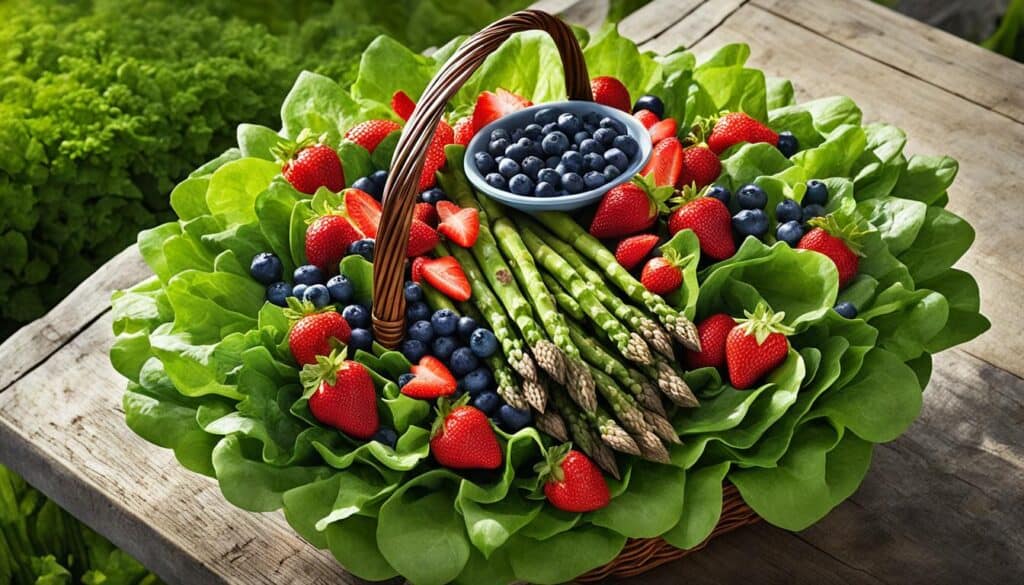
Enjoy the bounty of nature’s springtime offerings and savor the deliciousness of in-season fruits and vegetables. Whether you’re preparing a simple salad or exploring more adventurous culinary endeavors, incorporating these fresh ingredients into your meals will elevate your dining experience and nourish your body.
Summer Fruits and Vegetables
During the summer months, you can indulge in a wide array of fresh and delicious fruits and vegetables that are in season. From vibrant berries to juicy melons, summer brings an abundance of flavors and colors to your plate.
Summer Fruits:
Here are some of the mouthwatering fruits you can enjoy during the summer:
| Fruits |
|---|
| Apricots |
| Bananas |
| Blackberries |
| Blueberries |
| Cantaloupe |
| Nectarines |
| Peaches |
| Plums |
| Raspberries |
| Watermelon |
| Passionfruit |
These fruits are not only delicious but also packed with essential vitamins and minerals, providing a refreshing and nutritious summer treat.
Summer Vegetables:
In addition to the delectable fruits, summer also offers an array of vegetables that are at their peak in flavor and nutritional value:
| Vegetables |
|---|
| Artichokes |
| Arugula |
| Beans |
| Beets |
| Bell peppers |
| Carrots |
| Celery |
| Corn |
| Cucumbers |
| Eggplant |
| Fennel |
| Green beans |
| Okra |
| Onions |
| Peas |
| Potatoes |
| Radishes |
| Summer squash |
| Tomatoes |
These vegetables can be enjoyed in various dishes, from salads and stir-fries to grilled specialties, adding freshness and flavor to your summer meals.
Remember, the availability of these fruits and vegetables may vary depending on your location and the specific growing conditions in your area. To enjoy the best of summer’s bounty, visit local farmers markets or consider growing your own produce. Now, let’s get ready for a season filled with mouthwatering flavors and healthy eating!
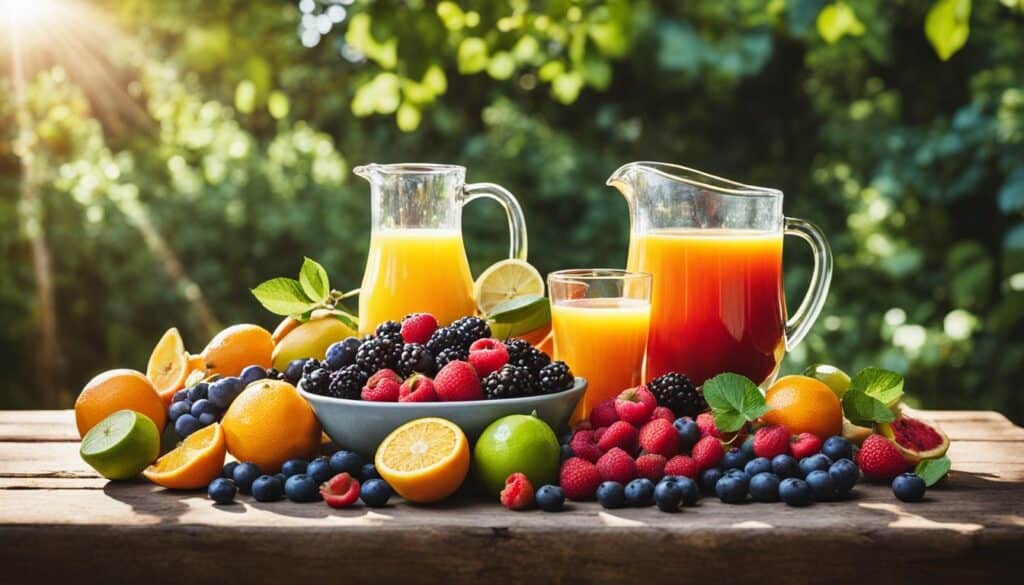
Autumn Fruits and Vegetables
In the autumn season, you can enjoy a delightful array of fruits that are in season. Some of the autumn fruits include:
- Apples
- Cranberries
- Figs
- Grapes
- Melons
- Pears
- Persimmons
- Pomegranates
These fruits are not only delicious but also packed with nutrients. Incorporating them into your autumn recipes will add a burst of flavor and vibrancy to your meals.
When it comes to vegetables, autumn brings a wide variety of options. Here are some of the vegetables that are in season:
| Vegetables in Season |
|---|
| Arugula |
| Beets |
| Broccoli |
| Brussels Sprouts |
| Cabbage |
| Carrots |
| Cauliflower |
| Chicory |
| Collard Greens |
| Kale |
| Leeks |
| Lettuce |
| Onions |
| Parsnips |
| Potatoes |
| Radicchio |
| Radishes |
| Rutabagas |
| Spinach |
| Sweet Potatoes |
| Turnips |
| Winter Squash |
These vegetables are not only flavorful but also provide essential nutrients for a healthy diet. They can be easily incorporated into hearty soups, roasted dishes, or even enjoyed raw in salads.
Please note that the availability of these fruits and vegetables may vary based on your location and the specific harvest times. It is best to check with local farmers markets or produce suppliers for the freshest, locally sourced autumn produce.
Quote:
“Autumn is the perfect time to savor the abundance of seasonal fruits and vegetables. Their flavors and colors enrich our meals and remind us of nature’s bountiful gifts.”
So, next time you’re shopping for groceries or planning your meals, don’t forget to explore the delightful flavors of the autumn season. Incorporating these fruits and vegetables into your recipes will not only elevate your culinary experience but also support local farmers and enjoy the freshest produce nature has to offer.
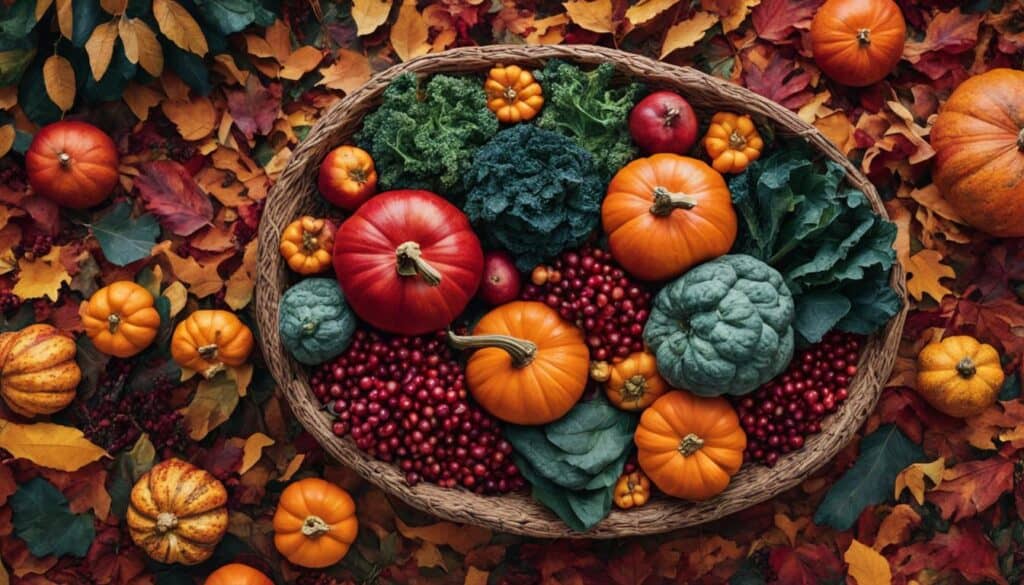
Where to Find In-Season Produce
When it comes to finding in-season produce, you have several options. Here are some places where you can discover the freshest and most flavorful fruits and vegetables:
- Local Farmers Markets: Visit your nearby farmers markets to explore a wide variety of in-season produce. You can directly support local farmers while enjoying the bounty of nature.
- Community-Supported Agriculture (CSA) Programs: Join a CSA program to receive regular deliveries of freshly harvested produce. By participating in a CSA, you become part of a community that supports sustainable farming practices.
- Supermarkets and Grocery Stores: Many supermarkets and grocery stores highlight in-season produce. Keep an eye out for displays and promotions that feature local and seasonal fruits and vegetables.
- Specialty Produce Stores: Specialty produce stores often offer a wider selection of in-season produce, including organic options. These stores are a great choice if you’re looking for unique or hard-to-find fruits and vegetables.
- Street Markets and Roadside Stands: In rural areas or during local festivals, street markets and roadside stands can be a treasure trove of fresh, in-season produce. Explore these vibrant outdoor markets for a unique shopping experience.
- Grocery Boxes and Produce Delivery Services: Services like Imperfect Foods and Misfits Market deliver grocery boxes filled with fresh produce straight to your door. These convenient options ensure you get high-quality in-season items without leaving home.
- Your Own Backyard: If you have a green thumb and some space, consider growing your own in-season produce. Planting vegetables and fruits in your backyard allows you to enjoy the rewards of your labor and connect with nature.
With these various options, you can easily find in-season produce to incorporate into your meals and support local farmers at the same time.
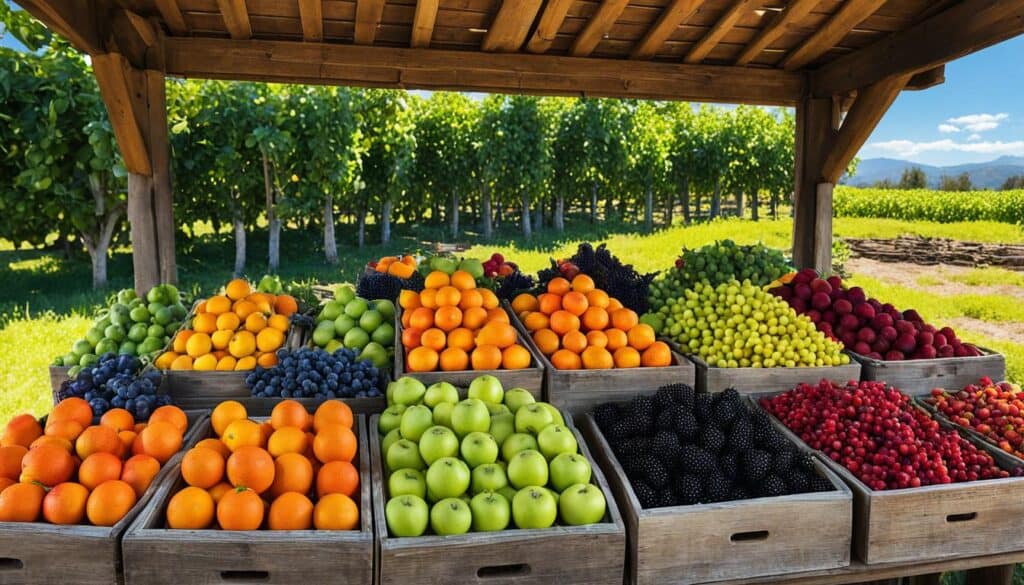
The Seasonality of Eating and Sustainability
Eating seasonally is not only a delicious way to enjoy fresh and flavorful food, but it also aligns with sustainable eating practices that benefit both your health and the environment. By understanding the seasonality of produce and choosing to eat in-season, you can contribute to reducing the carbon footprint of our food system.
When produce is out of season, it often requires long-distance transportation, resulting in increased greenhouse gas emissions. On the other hand, in-season produce is typically grown locally and requires less energy for transport, reducing its environmental impact. By opting for in-season fruits and vegetables, you can play a role in mitigating climate change and preserving our planet.
In addition to its positive environmental impact, eating seasonally also has numerous other benefits. In-season produce is harvested at its peak, ensuring maximum flavor, juiciness, and sweetness. It’s no wonder that a juicy summer peach or a ripe fall apple tastes so much more satisfying than their out-of-season counterparts.
Furthermore, eating seasonally offers a greater variety in your diet. Each season brings its own unique selection of fruits and vegetables, allowing you to explore new flavors and diversify your meals. From juicy berries in the summer to hearty root vegetables in the winter, there’s always something new to savor.
“Eating seasonally allows us to reconnect with the natural cycles of the Earth and support local farmers in our communities.”
By choosing to eat seasonally, you are also supporting local farmers and the local economy. Buying directly from farmers markets or participating in community-supported agriculture (CSA) programs not only ensures you’re getting the freshest produce but also helps sustain local agricultural communities.
Make sustainable eating a part of your lifestyle by embracing the seasonality of eating. The benefits extend beyond your plate to the health of the planet and the support of local farmers. So the next time you shop for groceries or plan your meals, consider what’s in season and enjoy the bounty that nature has to offer.
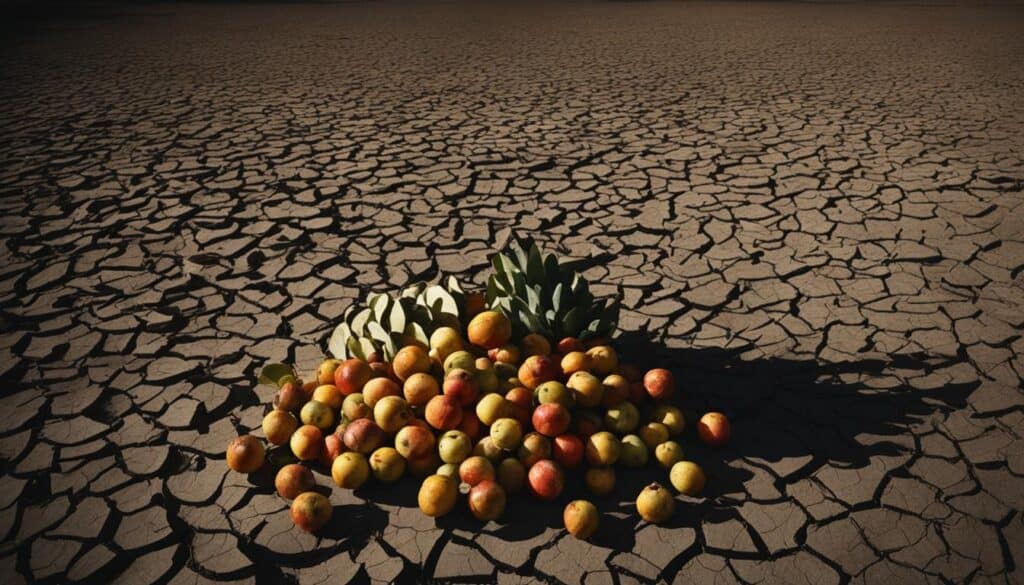
The Environmental Impact of Out-of-Season Produce
The carbon footprint of food is greatly influenced by the transportation required to bring it to our tables. Out-of-season produce often travels long distances before reaching the consumer, contributing to greenhouse gas emissions and the depletion of natural resources.
By choosing seasonal produce, you can significantly reduce the environmental impact of your food choices. Supporting local farmers decreases the need for long-distance shipping, reducing the energy consumption and emissions associated with transportation. Additionally, eating locally grown, in-season produce helps to maintain biodiversity and supports the health of local ecosystems, promoting sustainable agricultural practices.
Let’s take a moment to reflect on the environmental impact of our food choices and make a conscious effort to embrace the seasonality of eating. It’s a simple but powerful action that can contribute to a healthier planet for future generations.
Conclusion
Eating fruits and vegetables that are in season offers numerous benefits in terms of flavor, nutrition, cost, and sustainability. When you follow this ultimate fruit season guide, you can easily determine which fruits and vegetables are available during each season. By choosing seasonal produce, you not only get to enjoy the freshest flavors but also support local farmers and reduce the environmental impact of long-distance transportation.
Whether you prefer shopping at farmers markets, joining a community-supported agriculture (CSA) program, or growing your own produce, eating seasonally is a delicious and sustainable way to incorporate a variety of fruits and vegetables into your diet throughout the year. Seasonal eating ensures that you get the most out of each season’s bounty, allowing you to savor the natural ripeness and goodness of fruits and vegetables.
Remember, the best time to buy fruits is when they are in season. By paying attention to the fruit harvest calendar and using the fruit ripening guide, you can ensure that you pick fruits at their peak ripeness. For the freshest and most flavorful fruits, follow the fruit picking guide and consider fruit harvesting tips, such as gently squeezing the fruit to check for ripeness and looking for vibrant colors and fragrant aromas. So, embrace the seasons and enjoy the abundance of delicious and nutritious fruits that nature has to offer!
FAQ
What are the benefits of eating seasonally?
Eating seasonally allows you to enjoy produce at its peak ripeness, resulting in better flavor and increased nutritional value. It also offers a wider variety of fruits and vegetables in your diet, is often cheaper, and has a lower carbon footprint.
What fruits and vegetables are in season during winter?
Some fruits in season during winter include clementines, grapefruits, kiwis, kumquats, mandarin oranges, oranges, and tangerines. Vegetables in season during winter include beets, bok choy, Brussels sprouts, broccoli, cabbage, carrots, celeriac, garlic, kale, leeks, onions, parsnips, potatoes, radicchio, rutabagas, shallots, sweet potatoes, turnips, and winter squash.
Which fruits and vegetables are in season during spring?
In spring, you can find fruits such as avocados, cherries, lemons, limes, mangoes, pineapples, and strawberries. Vegetables in season during spring include asparagus, artichokes, arugula, beets, broccoli, cabbage, carrots, collard greens, fennel, leeks, lettuce, onions, peas, radishes, rhubarb, spinach, and turnips.
What fruits and vegetables are in season during summer?
During the summer months, you can enjoy a variety of fruits including apricots, bananas, blackberries, blueberries, cantaloupe, nectarines, peaches, plums, raspberries, watermelon, and passionfruit. Summer vegetables include artichokes, arugula, beans, beets, bell peppers, carrots, celery, corn, cucumbers, eggplant, fennel, green beans, okra, onions, peas, potatoes, radishes, summer squash, and tomatoes.
Which fruits and vegetables are in season during autumn?
In autumn, you can enjoy fruits such as apples, cranberries, figs, grapes, melons, pears, persimmons, and pomegranates. Vegetables in season during autumn include arugula, beets, broccoli, Brussels sprouts, cabbage, carrots, cauliflower, chicory, collard greens, kale, leeks, lettuce, onions, parsnips, potatoes, radicchio, radishes, rutabagas, spinach, sweet potatoes, turnips, and winter squash.
Where can I find in-season produce?
You can find in-season produce at local farmers markets, through community-supported agriculture (CSA) programs, supermarkets, specialty produce stores, street markets, roadside stands, grocery boxes, produce delivery services, and by growing your own in your backyard or indoors.
What are the environmental benefits of eating seasonally?
Eating seasonally reduces the carbon footprint of your food by minimizing long-distance shipping. It also supports local farmers and the local economy, as well as fosters a sense of community.
How does eating seasonally align with sustainable eating practices?
Eating seasonally reduces the environmental impact of out-of-season produce, supports local agriculture, and promotes a healthier and more diverse diet. By choosing seasonal produce, you are making a sustainable choice for both your health and the planet.
Why should I eat fruits and vegetables that are in season?
Eating fruits and vegetables that are in season offers numerous benefits, including improved flavor, increased nutritional value, lower cost, and sustainability. It allows you to enjoy the freshest and most delicious produce while supporting local farmers and reducing your carbon footprint.

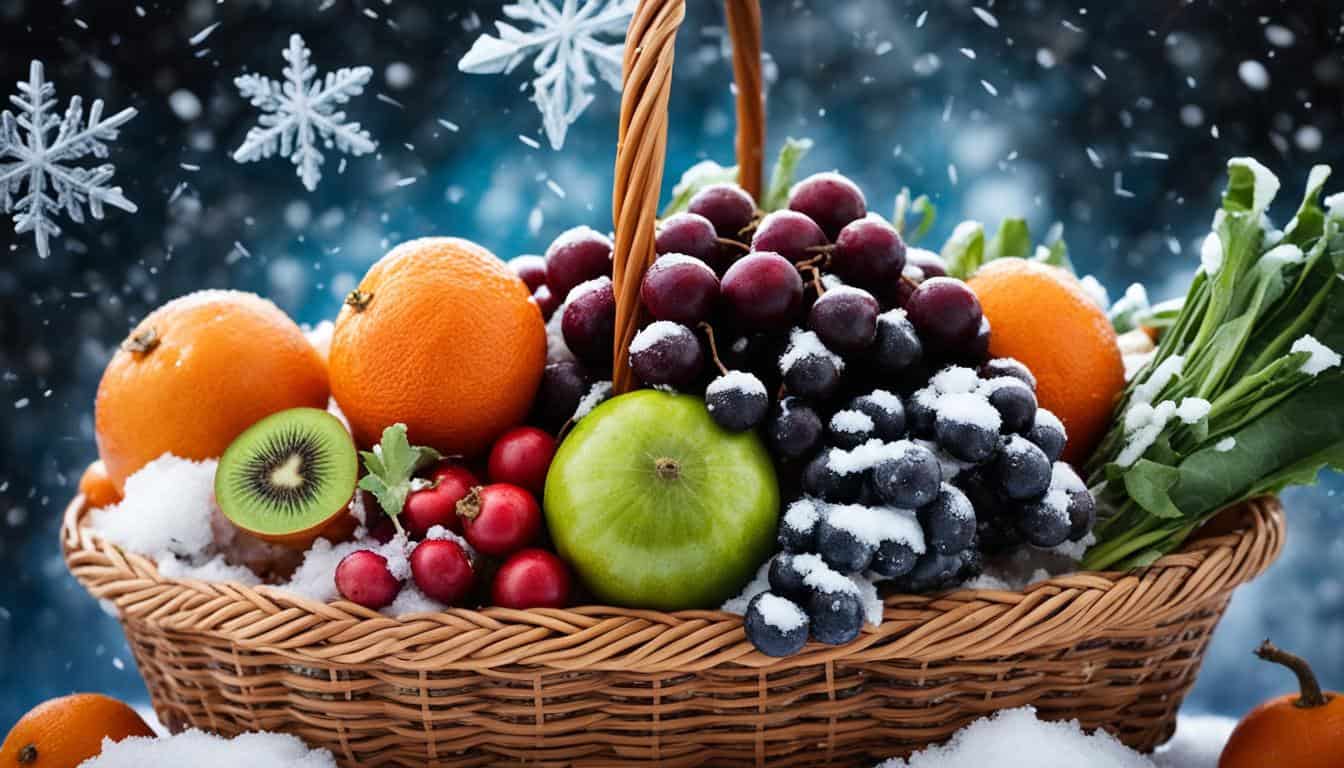



Leave a Reply